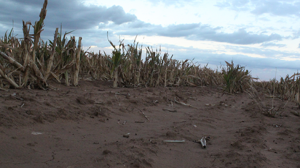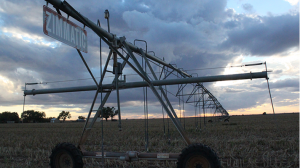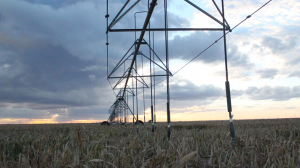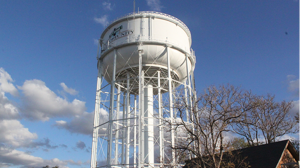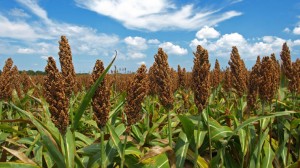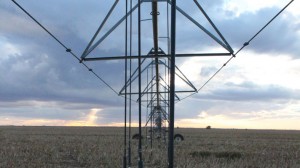“We have been in a historic drought for the past few years, but even before that, we’ve been using water from the Ogallala Aquifer at a rate which is not sustainable.”
Julie Hodges, the Helen Devitt Jones endowed manager of education programs at the National Ranching Heritage Center, said the city of Lubbock has been searching for alternative water sources for a long time, even since the 1950s.
Interview with Julie Hodges, the Helen Devitt Jones endowed manager of education programs, at the National Ranching Heritage Center
Hodges said this search began with the establishment of Canadian River Municipal River Authority, or CRMWA, and the building of Lake Meredith reservoir on the Canadian River in the 1950s.
“The city of Lubbock is actually responsible for — municipalities in general, on top of the Ogallala — are actually responsible for only about 10 percent of water — 90 percent are used for agricultural purposes.”
Hodges said while we have been the breadbasket of the High Plains for a long while, the aquifer has become unstable because of that.
According to the City of Lubbock Water Quality Report, water from the Ogallala Aquifer is pumped from Roberts and Bailey counties well-fields. In 2013, this water accounted for 83 percent of the water supply in the city of Lubbock. The other 17 percent came from Lake Alan Henry.
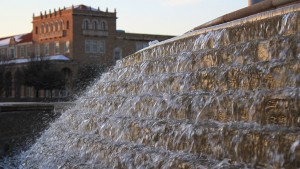
According to the City of Lubbock Strategic Water Plan, a recent rain surge brought the decommissioned Lake Meredith back into supplementary use. Lake Meredith was decommissioned in 2011.
Dana Porter, Ph.D, an agricultural engineer for the Texas A&M Agrilife Extension in Lubbock, said while the aquifer is decreasing, growers in the area are adopting new efficient technologies to compensate.
“Well mostly what we got here in this area is groundwater from the Ogallala,” Porter said, “There are a few people who are starting to drill deeper into the Dockum or Santa Rosa Aquifer.
“The water quality in the Dockum tends to be poorer, or saltier, so it changes the management strategies.”
Porter said, in the end, it is the management strategies that need the most work in order to conserve water in the agriculture side of the Southern High Plains.
“We have the highest adoption rate of these efficient technologies,” Porter said.
Porter said the efficient technologies included crop rotation and center-pivot irrigation.
Interview with Dana Porter, Agricultural Engineer at Agrilife Extension
Hodges said that conservation is something we need to practice more in the city of Lubbock and is something many of us here are not the best at.
“There are ordinances,” Hodges said, “but they are not enforced here in the city of Lubbock, and it kind of comes down to what kind of crop you’re growing — even in the city. We have to look at what we’re growing in our yards and the way we use water in our houses.”
According to the United States Census Bureau, the population of Lubbock was 239,538 in 2013 — a 4.34% increase from 2010, when the population was 229,573.
Mycah Druesedow, a senior early education major at Texas Tech said she has noticed more drought resistant plants around campus in the past few years. In her everyday life, she also tries to conserve water.
“Just a lot of taking short showers,” Druesedow said, “turning water off, the stuff you learn when you’re little, like turning it off when you’re brushing your teeth, and when we cook, using it sparingly.”
Other Tech students are simply aware there is a problem.

“I’m sure that there’s a drought,” said Moriah Gold, a senior mechanical engineering major from Denver, Colorado, “but there seems to always be a drought everywhere, not just in Lubbock.”
Hodges said she does not feel optimistic about the use of Lake Alan Henry.
“Lake Alan Henry at its best can only provide 25 percent of our current usage for the city of Lubbock,” Hodges said, “In addition, pumping water uphill is an expensive venture. I don’t think it is a sustainable thing. Also, can we afford to pump water uphill for that long?”
According to Texas Parks and Wildlife Water Data for Texas, Lake Alan Henry has risen 3.09 feet in one year and is approximately 75 percent full.
According to the Lake Alan-Henry Supply Project Environmental Assessment, three pump stations are needed in addition to a water treatment plant and more than 60 miles of pipe to provide additional drinking water to the city of Lubbock. Different contaminants are treated there. Additional information about this can be seen here.
The assessment projected a total annual cost of $17.7 million annually for the entire operation.
